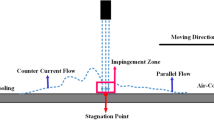Abstract
In the production of carbon-manganese hot rolled steel strips, less than 6 mm thickness, the wound coil had a shape defect associated with coil collapse. The defect was overcome by the assessment of physical simulation of the associated phase transformations in the run out table using Gleeble. It was found that when the steel strips had a lower Ar1 temperature than the coiling temperature, the occurrence of coil collapse was common. The coil collapse is due to the secondary phase transformation taking place during coiling and coil holding, where the liberation of the transformation heat softens the coil that leads to the coil collapse. Hence, by optimization of the hot rolling conditions such that the phase transformation is completed at the ROT before coiling, it is possible to avoid the coil collapse. Gleeble based physical simulation of the cooling pattern was correlated with the theoretical Ar1 temperature to enable prediction of the coil collapse possibility. Based on the physical simulation of the different cooling conditions, imposition of the correct cooling condition at the industrial ROT enabled elimination of coil collapse. In addition to avoiding coil collapse, the production loss associated with 4 to 5 min holding at the down coiler was overcome.









Similar content being viewed by others
References
Banks K, Tuling A and Mintz B 2011 Influence of Chemistry and Runout Table Parameters on Hot Coil Collapse in C-Mn Steels. Ironmak. Steelmak. 38(3): 204–210
Anderssen B, Fowkes N, Hickson R and McGuinness M, 2009 Study report by BlueScope steel. In: Proceedings of Conference MISG-2009: 90–108
Jae P C, Yoon K S and Lee C H 2010 Advanced temperature control of high carbon steel for hot strip mills. J. Mech. Sci. Technol. 24(5): 1011–1017
Suebsomran A and Butdee S 2013 Cooling process on a run-out table by the simulation method. Case Stud. Therm. Eng. 1(2013): 51–56
Serajzadeh S 2003 Modelling of temperature history and phase transformations during cooling of steel. J. Mater. Process. Technol. 146(2004): 311–317
Biswas S K, Chen S J and Satyanarayana A 1997 Optimal Temperature Tracking for Accelerated Cooling Processes in Hot Rolling of Steel. Int. J. Dyn. Control. 7(4): 327–340
Jahanian S and Mosleh M 1999 The Mathematical Modeling of Phase Transformation of Steel during Quenching. J. Mater. Eng. Perform. 8(1): 75–82
Suh D W, Oh Ch S, Han H N and Kim S J 2007 Dilatometric analysis of austenite decomposition considering the effect of non-isotropic volume change. Acta Mater. 55: 2659–2669
Gorni A A (eds) 2017 Handbook of Steel Forming and Heat Treating (Sao Vacente, Brazil) Available: http://www.gorni.eng.br/ (Accessed January 2018)
Author information
Authors and Affiliations
Corresponding author
Rights and permissions
About this article
Cite this article
Akela, A.K., Tripathi, P.K., Vastrad, M. et al. Optimization of run-out table cooling parameters to control coil collapse in carbon-manganese steels. Sādhanā 46, 106 (2021). https://doi.org/10.1007/s12046-021-01629-w
Received:
Revised:
Accepted:
Published:
DOI: https://doi.org/10.1007/s12046-021-01629-w




